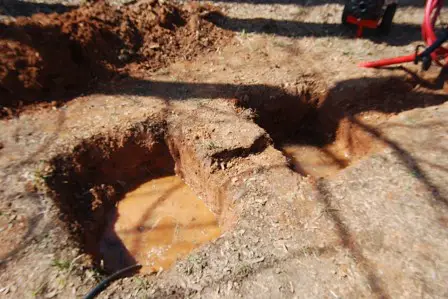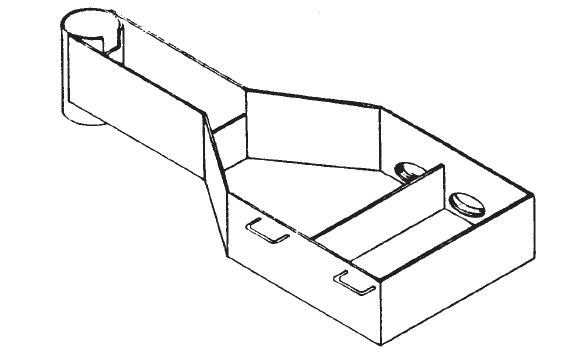Using a Mud Pump with a Portable Mud Pit
Historically, most drillers dug two pits prior to drilling a well. A first pit, called a settling pit, received the drilling fluid and cuttings from the drill hole via a short shallow trench. The cuttings settled down to the bottom of the the settling pit. A second pit, called a mud pit, was dug nearby and a second trench directed the overflow of the settling pit into the mud pit. Most of the cuttings settle to the bottom of the settling pit and the drilling fluid in the mud pit has a much higher liquid to cuttings ratio. In other words, the water in the second pit, the mud pit, is “cleaner.” Drilling fluid from the mud pit is then pumped, by a mud pump, back down the drillpipe. During the drilling process, cuttings are continuously shoveled from the settling pit so it does not become clogged with cuttings. Although most of the cuttings settle in the settling pit, it is also necessary to occasionally shovel cuttings from the mud pit as well.
The process is well illustrated in this drawing from the Lifewater site below:

Diagram from Lifewater
Below is a photograph of mud pits prepared for drilling. This photograph is from the hydra-jett site. Hydra-Fab manufacturing http://hydra-jett.com/index.html sells small and medium sized drilling rigs and is worth looking at if you are considering moving up to a small rig.

As you might imagine, diggining mud pits is a significant undertaking and it makes an even bigger mess of your drilling site. Modern drillers, being both ingenious and capitalistic souls, have devised a way to avoid this costly, unpleasant step. They bring portable mud pits to the drill site. A portable mud pit is simply a container or series of containers that the drilling fluid from the hole is directed to where cuttings settle out prior to the fluid being pumped again down the drillpipe. Not only does it eliminate the time/money consuming digging but it leaves a cleaner drillsite upon completion of the well.
….but it frequently doesn’t work as well for those of us who have small portable mud pits. Using real mud pits results in more efficient drilling. There is no leakage around the guide tube with real mud pits.
Here is an example of a portable mud pit positioned at the back of a commercial drilling rig. Cuttings from the hole are directed into the settling pit on the right. Then drilling fluid passes through to the mud pit on the left and it is pumped back down the hole.

COMMERCIAL SETUP – PORTABLE MUD PIT

WIDER VIEW – COMMERCIAL MUD PIT SETUP
There is a wide variety of designs of portable mud pits. Here are just a few sketches I found to give you an idea of designs that folks have come up with.

from US Army Drilling Manual
http://rdl.train.army.mil/catalog/view/100.ATSC/E410BF83-C22A-4330-9350-DD056750B4F6-1274313873272/5-484/Ch5.htm

So, by now your are probably wondering, where does all that leave us? We are not going to buy one of those $500 portable mud pits for our $200 project are we? Absolutely not, in fact you may just be better off digging your pits. If you are going to dig several wells you might want to consider using a portable mud pit with a mud pump. I made one out of wood and it works fine. It is not as efficient as the commercial mud pits but it does the job. Please take a look at the video below.
As you can see my portable mud pit is just a wooden box with a fitting for the suction line and a minor obstruction to keep the cuttings away from the suction. You can probably come up with a better design for a portable mud pit that I have. I probably could but it is already built and I’m not inclined to build another one – but – If I were doing another one, I’d probably build two boxes that fit inside one another for easier travel and storage, and then sat beside each other when drilling.
If you build a portable mud pit, PLEASE! send me a picture! mike.willis@runbox.com Good luck!
 drillyourownwell.com
drillyourownwell.com